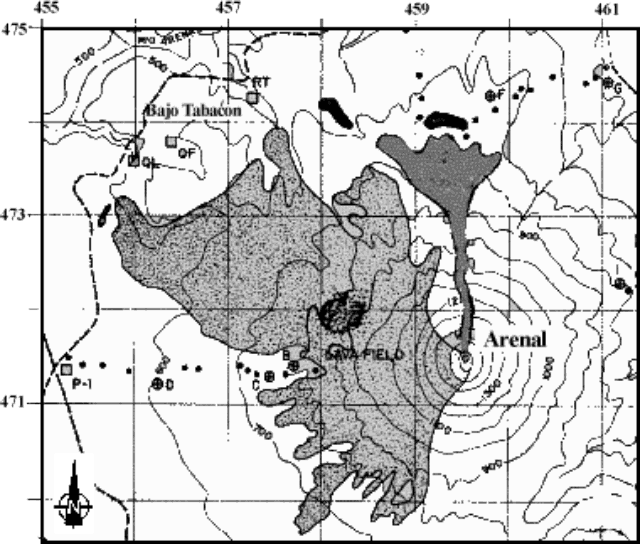Report on Arenal (Costa Rica) — July 2000
Bulletin of the Global Volcanism Network, vol. 25, no. 7 (July 2000)
Managing Editor: Richard Wunderman.
Arenal (Costa Rica) Larger-than-average pyroclastic flow engulfs three people on 23 August
Please cite this report as:
Global Volcanism Program, 2000. Report on Arenal (Costa Rica) (Wunderman, R., ed.). Bulletin of the Global Volcanism Network, 25:7. Smithsonian Institution. https://doi.org/10.5479/si.GVP.BGVN200007-345033
Arenal
Costa Rica
10.463°N, 84.703°W; summit elev. 1670 m
All times are local (unless otherwise noted)
During January to July 2000 Arenal's outbursts generally remained low but included frequent pyroclastic explosions, gas emissions, and avalanches. In late August explosions spawned a pyroclastic flow that injured three people several kilometers from the crater; two later died. Three days later a small airplane crashed into the volcano.
In January through parts of June crater C continued its usual activities, consisting of a constant gas emission, sporadic Strombolian eruptions, and occasional incandescent avalanches. Crater D exhibited fumarolic activity. The lava continued to flow variously toward the NNE, E, SE flanks. The NE and SE flank were continually affected by acid rain and pyroclastic material that contributed to the destruction of the vegetation on these flanks, resulting in major erosion that created small avalanches on the rivers Calle de Arenas, Manolo, Guillermina, and Agua Caliente.
The EDM network (established along the subradial lines) continued to show an average annual contraction of 7-10 ppm. The dry inclinometers ("dry tilt") showed variations in the radial component, deflation at ~5 µrad per year.
During the last half of April and throughout May eruptive activity increased, but few ash columns rose to ~500 m over crater C. The columns of ash were carried by the predominating winds toward the NW and SE flank causing both acid rain and ash fall. In May a narrow channel of lava began to flow toward the NNE flank. It later widened into a fan burning vegetation on the N and NE flanks.
From April to May the seismometer detected an increase in both number of eruptions and the hours of tremor. On 16 May two MR 3 earthquakes were recorded and located on the flanks of the volcano at 2 and 5 km from the summit. These earthquakes were reported to be felt in La Fortuna, 6.5 km NE of the volcano.
Eruptive activity remained low in June; few eruption clouds rose more than 500 m over crater C. In July crater C continued with the emission of gases, lava flows, sporadic Strombolian eruptions, and occasional pyroclastic flows. The eruptive activity increased in July with respect to June, although the number of eruptions, their intensity, and the quantity of pyroclastic material ejected remained low.
In August Arenal became more active and underwent a series of explosions. One began at 0945 on 23 August; mutiple pyroclastic flows came down the volcano's NE side (figure 89) as a series of pulses. Pulses occurred at 0955, 0956, and 0958. The most important pulse occurred at 1001 and continued for six minutes. Two more pulses followed at 1008 and 1012. For the next two hours activity returned to normal, but at 1323 a new series of explosions began. At 1336 a pyroclastic flow began and lasted for ten minutes. Various pulses descended the NNE flank. Normal low-level activity resumed 19 hours after the afternoon explosions.
News reports. One of the pyroclastic flows on 23 August engulfed a Costa Rican tour guide and two tourists from the United States. OVSICORI-UNA stated that the victims were burnt by the front of the flow ~2.3 km from the crater. According to a local volcanologist, the flow was traveling at 80 km/hour at that point.
The three victims were sent to San José to be treated for their burns and injuries. On the night of 23 August the tour guide died in the hospital. An 8-year-old girl from Massachusetts died on 6 September as a result of her burns.
The National Emergency Commission (NEC) ordered evacuations of the tourist centers of Los Lagos, the Tabacón hot springs and resort, Hotel Montaña del Fuego, Arenal Lodge, and other areas. The NEC and Red Cross workers evacuated 600 tourists and residents and closed the route around the volcano to Tilarán. On 24 August the volcano returned to its normal behavior. The 23 August explosive eruptions were believed to be the strongest since the deadly 1968 eruption.
On 26 August a ten-passenger airplane crashed into the NE flank ~200 m below the summit. All of the occupants died. The cause of the crash is unknown at this point and no further details are available.
Geological Summary. Conical Volcán Arenal is the youngest stratovolcano in Costa Rica and one of its most active. The 1670-m-high andesitic volcano towers above the eastern shores of Lake Arenal, which has been enlarged by a hydroelectric project. Arenal lies along a volcanic chain that has migrated to the NW from the late-Pleistocene Los Perdidos lava domes through the Pleistocene-to-Holocene Chato volcano, which contains a 500-m-wide, lake-filled summit crater. The earliest known eruptions of Arenal took place about 7000 years ago, and it was active concurrently with Cerro Chato until the activity of Chato ended about 3500 years ago. Growth of Arenal has been characterized by periodic major explosive eruptions at several-hundred-year intervals and periods of lava effusion that armor the cone. An eruptive period that began with a major explosive eruption in 1968 ended in December 2010; continuous explosive activity accompanied by slow lava effusion and the occasional emission of pyroclastic flows characterized the eruption from vents at the summit and on the upper western flank.
Information Contacts: Observatorio Vulcanologico y Sismologico de Costa Rica, Universidad Nacional (OVSICORI-UNA), Apartado 86-3000, Heredia, Costa Rica; Oficina de Sismología y Vulcanología del Arenal y Miravalles (OSIVAM), Instituto Costarricense de Electricidad (ICE), Apartado 10032-1000, San José, Costa Rica; The Tico Times (URL: http://www.ticotimes.net/); La Nacion (URL: http://www.nacion.co.cr/).


